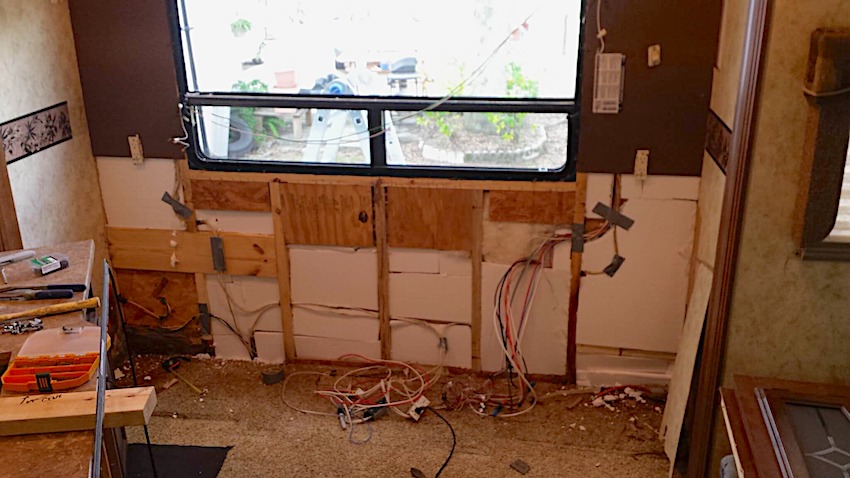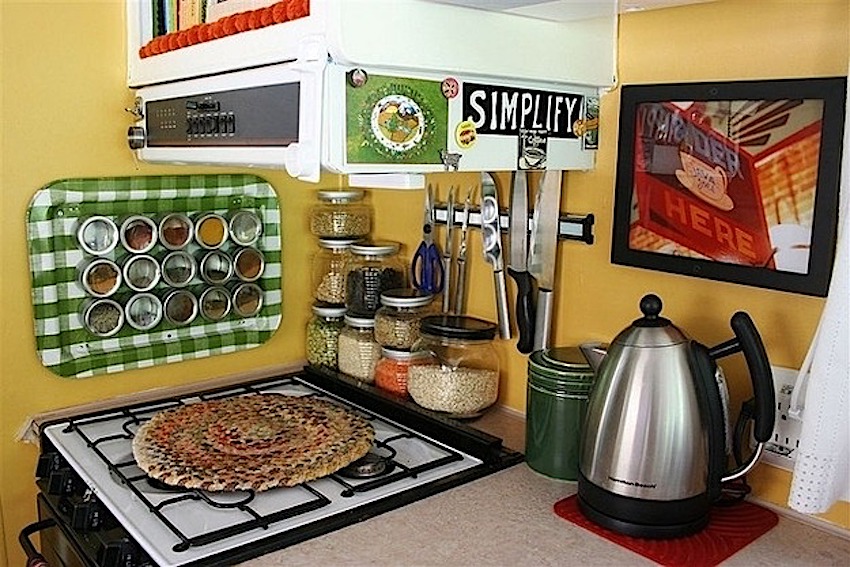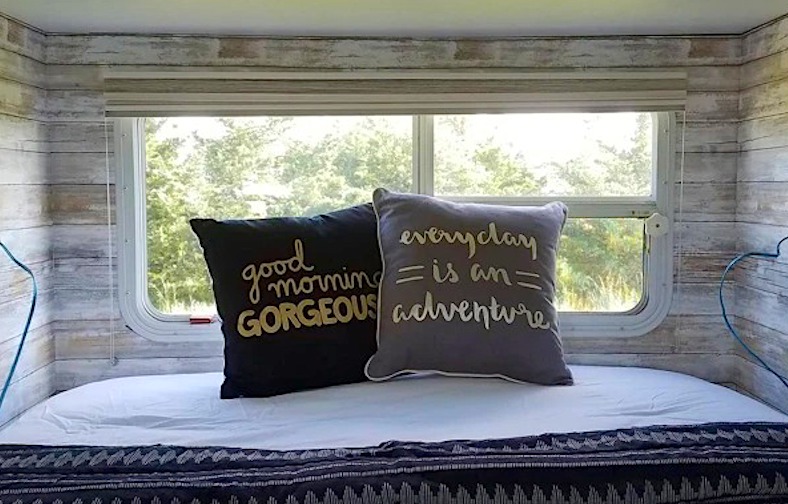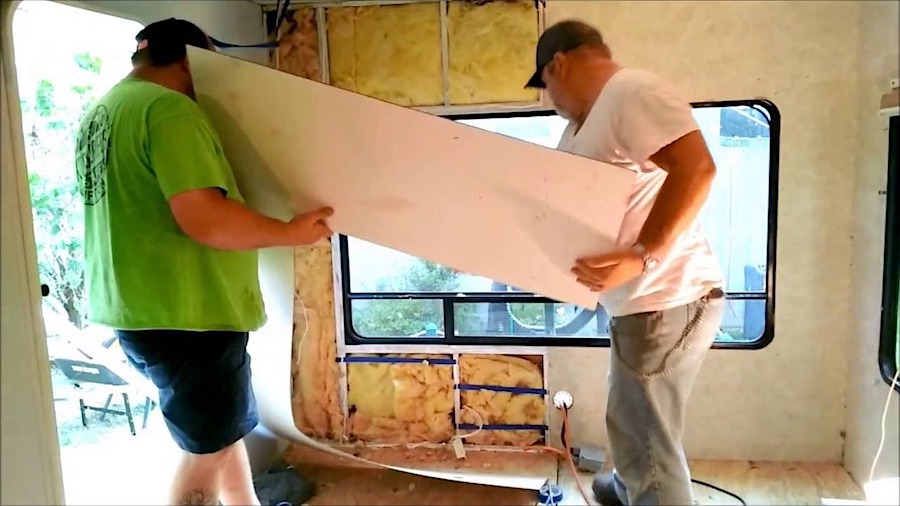Thanks for your support! If you make a purchase using our links in this article, we may make a commission. And, as an Amazon Associate, I earn from qualifying purchases. See the full disclosure here.
Do you need to remove, repair, or replace your RV or camper interior walls? Well, you are in the right place to learn how interior walls are constructed, how to remove or replace them, and the best materials to replace them. But first, you should take some time to learn what RV walls are made of so you know what you are getting into.
If you have water damage or you are looking to remodel your RV, with a small budget and a little effort, you can renovate your RV into the home of your dreams with a little knowledge of what interior RV walls are made of.
In this discussion, we’ll show you everything you need to know about your RV interior walls. The purpose and materials used are quite different than the exterior RV walls. We’ll show you the many possibilities of what you can do to update your decor. If you need to remove and replace the wall panels, our tips will help prevent a simple project from turning into a major undertaking.
Are RV Interior Walls Load Bearing
Unlike a sticks and bricks house, RV interior walls aren’t load-bearing. Like a passenger vehicle, the main support comes from the wood or aluminum frame that makes the skeleton of your coach. The exterior walls act as secondary support for your roof.
Sub-beams connected to the frame support cabinets, windows, and other wall features. The frame or chassis brace slideouts. The interior RV walls have a much different purpose.
The RV interior walls act as a skin that covers up insulation material, wall framing, and the various utility arteries like electric wires. They come in panels made up of materials that are ideal for road travel and various weather conditions. Manufacturers use materials that have the ability to balance durability and accept finishing products like wallpaper or paint.
What is Between the Interior and Exterior Walls of an RV

Many RV manufacturers, like Jayco, build their sidewalls to be strong, lightweight, and well insulated. The latest technologies in building material and processes have created RV exterior walls to be strong and insulating. Materials like Azdel have thermal and sound insulating properties.
Exterior walls and insulation now go through a bonding process using extreme weight, heat, and glue to bond them together. This process creates an airtight seal that’s lightweight and strong. It’s then laminated to give these materials years of integrity.
The aluminum or wood frame fits behind these bonded pieces. The frame itself has openings cut strategically to fit things like:
- Electrical wires
- Water lines
- Propane piping
- HVAC ducting
- Audio/Video cabling
- Various other components
To learn even more about RV exterior wall insulation check out our article called Travel Trailer and RV Insulation Guide: R-Values Explained. And to learn about all the different ways RVs are built see our article called RV Construction Methods: Which Is Best?
Typical RV Interior Wall Materials
RV and camper interior walls are made of three different types of materials. Each has its benefits and burdens. You’ll see this in motorhome interior wall panels and towable travel trailers.
Vinyl
Vinyl is a great material for do-it-yourself folks since it’s affordable, easy to work with, and comes in almost any design imaginable. During installation, if your measurements aren’t quite right, a quick fix with a utility knife will give you the perfect fit. In later years, you may see some cracking as it dries out.
Plywood
You’ll see plywood mostly in older RVs. This multi-layered wood material gets its strength and flexibility due to the perpendicular cross sections. While it’s the heaviest of the three, it’s a great building material due to the fact that it doesn’t warp. If you decide to replace or repair your RV interior walls with plywood, keep in mind that it’s prone to rot, mold, and water damage.
Medium Density Fiberboard
Master home builder Bob Vila defines medium density fiberboard (MDF) as dehydrated sawdust, that comes from industrial milling. It’s mixed with either wax or resin that’s formed into boards. The boards are then exposed to extreme heated pressure to become plyboard-like building material. MDF has a smooth outer layer that accepts paint and finishes beautifully.
RV paneling with automotive HDF board is different than MDF. Auto, furniture, and other builders use high-density fiberboard for its structural strength. It doesn’t accept paint or wallpaper.
Can I Remove RV Interior Walls
Before you call forth your inner Ty Pennington with that 30-pound sledgehammer, removing RV interior walls is more of a surgical procedure than an all-out massive assault. Your RV walls are only a couple of inches thick and have a lot of utility essentials running through them. If you swing too hard, you could punch straight through the other side.
Flat crowbars or nail pullers are the best tools for removing the glued RV interior wall panels. Before you begin, research your particular coach’s design so you know where the various wires and pipes exist. Your next step is to disconnect everything from the wall paneling.
. This includes:
- Electric outlets
- USB charging stations
- Lighting and other electrical components
- Control panels
- Cabinetry
- Furniture
- Window valances
- Dinette table brackets
For safety, we recommend personal protective equipment (PPE) such as work gloves, eye protection, and dust masks. You’ll want to avoid splinters, dust, and any potential contaminants you may find in the walls. Even if you keep up on your preventive maintenance, mold and mildew are sneaky.
Can You Hang Things on Interior RV Walls

Your home on wheels isn’t complete without your family photos, decor enhancing art pieces, and functional storage hacks. Hanging things on your interior RV walls has become its own artform within the RV community. You need something to secure your hung items that will withstand the punishment of the road but won’t destroy your walls.
Using nails or screws creates holes in the RV wall paneling. Interior walls are too thin to support any weight. The last thing you want is to nail into an electrical line or create a hole in a water pipe.
Using products like adhesive plastic hooks and/or velcro with a glue backing have the strength to accommodate travel. These methods have the added bonus of hiding or blending in with your decor since they come in a variety of colors. The best part about them is the ability to move your hanging items around to keep your functional and aesthetic space fresh.
Remodel RV Interior Walls
Remodeling your RV interior walls can make your coach uniquely yours. With a little preparation, you can complete this D.I.Y. project within a day or two. The end result can make your coach look like it belongs in the million-dollar club.
Can I Paint Interior RV Walls?
The first step in the painting process is preparing your trailer interior wall panels. You will need to sand and degrease your walls to have a fresh surface to paint. Once complete, the rough surface is perfect for your primer and paint.
If you’re a full-time family that homeschools your children, painting has an additional advantage. Dry erase board paint or chalkboard paint turns your RV wall into a presentation board. Even if you don’t need it for homeschooling, this is a great solution for memos, creative drawing, or other purposes.
If you plan on refinishing the wood, but don’t know the specific stain color, you can contact the manufacturer. Regardless of the RV’s age, they have records of the stains they use. You can speak with them about either mixing up a special batch for you or learn about a similar color that they currently use.
Can I Wallpaper Interior Camper or RV Walls?

Manufacturers use wallpaper as a standard feature. RV interior wallpaper can last over 10 years. If exposed to high humidity for long periods of time, it can begin to peel.
Replacing wallpaper or switching to paint is something you can do on your own. The most difficult part is removing the wallpaper glue. You’ll need a specialized scraper to eliminate all of the glue from the walls.
As you shop for new camper wall covering, you’ll need to find RV interior paneling seam tape that matches your wallpaper. This tape covers those corners and seams that the wallpaper can’t cover. The final result will give you a consistent look.
Can I Tile Over RV Interior Walls?
Ceramic tile has a great look to it. Unfortunately, this type of tile isn’t roadworthy. Even on a short trip, by the time you reach your destination, you’d find most of your tiles cracked.
You will see stone tiles in high-end class A motorhomes for flooring and other features. This category can handle the weight and temperament of these tiles. Other categories of RV don’t have the suspensions or weight capacities to make stone tile a reasonable option.
An alternative that gives you the same appearance is vinyl peel-and-stick tile. These sheets come in virtually every pattern you can imagine. Many RV makers use them as backsplashes in the kitchen area.
D.I.Y.ers will enjoy this project since they are easy to trim, simple to put up and stick to any surface. The best part is this material’s affordability and marginal weight. You’ll also enjoy the painless effort of cleaning it.
RV Wall Decor Ideas
Like a house, your RV interior walls can be your blank canvas. A quick Google search for RV wall decor ideas will show you what others have done to make their home on wheels unique. Some hang their favorite pictures and art, while others perform their own extreme makeover.
If you need to repair your RV interior walls, this may be a great opportunity to get creative. Refinishing your interior can give you that homey feel. What better way to enjoy the RV lifestyle than to have something you designed yourself.



Thanks. Very helpful. We are in the process of updating our Tioga’s interior. Walls had dusty rose, blue-green plastic wallpaper. We cleaned all, painted all with Kilz, then wallpapered it with texturized wallpaper with A stucco texture, and painted it a soft yellow, to compliment the reupholstered blue seats, trim and curtains. Came out very nicely. Some re-gluing of edges required now and then, but easy to do.
Acquired a small older Boller size trailer camper with a foam like interior walls to ceiling. What can I expect if I take this down and what can you recommend for this fibre glass trailer.
Canada
We recently purchased a 2003 R-Vision Trail-Lite Class B+. The interior needs a lot of TLC. We are considering redoing some of the walls with vinyl planking. We live in Canada and are wondering how the adhesive on vinyl planks or tile withstand our extreme cold temperatures while its is storage.
Gonna do the inside of a Terry travel want too insulate heavy as I live in Canada any info I can get would be appreciated
Hello, I have some water damaged interior walls it seems. How would you recommend fixing them?
Thank you for the advice.
I have just found a bad leak on my 2008 Compass Avantgarde motorhome and I need to remove one wall for renovation as it is soaked. (Covid meant we didn’t get away as much this year so it has been lying in the drive).
Trying to source a diagram of how the body was built. Any ideas?
Keep the good advice coming.
All the best